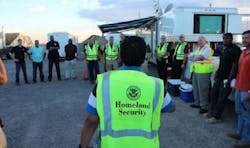DHS Event Probes Communications Interference
June 9-- The Department of Homeland Security will host its second event this summer aimed at exploring the causes of signal interference and ways that first responders can overcome issues with their communications systems.
The DHS Science & Technology Directorate's "JamX 17" event will be held July 16-22 at the U.S. Department of Energy's Idaho National Laboratory and will feature nearly 350 attendees from 108 agencies across the country, according to Sridhar Kowdley, Program Manager for DHS S&T.
Much like the 2016 event held last July at the White Sands Missile Range in southern New Mexico, "JamX 17" will involve simulating upwards of 70 to 80 scenarios to help educate first responders on some of the problems that can arise with their communications - both natural and intentional. The simulations range from traffic collisions to biohazard and terror events.
"Signal interference happens," Kowdley said during a recent Facebook Live TechTalk hosted by DHS S&T. "It's just an occurrence and it doesn't always have to be intentional."
Kowdley says that while unintentional causes -- such as solar flares, microwaves, incorrect programming or even baby monitors -- have been known to cause problems with emergency response communications, DHS has turned its main focus toward broadband signal jammers intentionally designed to cause interference.
Such jammers are illegal in the United States and other countries, but they are legal elsewhere and have found a market in this country.
"Unfortunately, some of the stuff gets in from overseas," Kowdley said.
That market may not necessarily be one of malicious intent, but can still pose a threat. A Chicago man was arrested in March 2016 and charged with a misdemeanor for using a signal jammer he imported from China on a CTA train because he said fellow commuters got on his nerves when using their cellphones.
While the man was lauded by some for his bold actions, the risk to the city's public safety communications in the event of an emergency shouldn't be taken lightly. Such an event can not only put a member of the public at risk, but first responders as well. Signal interference was after all a significant factor for New York City firefighters and emergency crews on Sept. 11, 2001.
"Our idea is for a first responder (being) protected with everything from duty uniforms that are chem and bio resistant all the way to communications systems," Kowdley said of the DHS S&T mission.
Kowdley says one of the more significant findings from last summer's event was the general lack of knowledge on the technical aspects of communication systems and signal jammers among first responders, which he acknowledged was understandable but also easily avoidable.
"We found that there are training gaps. Public safety (officers) are trained on their weapons... and they have to go back and get re-certified, but we don't have continuous training on radios. Usually (first responders) are given a radio and limited training."
There are simple things Kowdley says can help mitigate issues that arise from signal jamming. Having a system with multiple bands is one, while the simple task of noting every instance of signal interference can also help. First responders may experience a brief communications issue in the heat of the moment and think nothing of it after some times passes, but the chance that a jammer might have been used in the area should be explored.
"We will educate first responders as much as possible as well as the agencies and those who are operating and maintaining the networks," said Kowdley.
DHS Science & Technology has made the findings from last year's event and plans for "JamX 17" available through its website.
